|
As
Rodin sometimes confided to his friends, he had abandaned his Catholic
faith after a period of intense repentment in a monastery, following the
death of his sister Maria.
He rather fostered a pantheist vision, in which any element of Life and
Nature could be perceived as a representation of truth and beauty.
His occupation with a clearly religious
subject like 'Christ and Mary Magdalene' in 1894 is an exception and needs
some attention. following the
death of his sister Maria.
He rather fostered a pantheist vision, in which any element of Life and
Nature could be perceived as a representation of truth and beauty.
His occupation with a clearly religious
subject like 'Christ and Mary Magdalene' in 1894 is an exception and needs
some attention.
For an explanation, Elsen points
to a number of
incidents that utterly frustrated Rodin during the early 1890's:
his design for a 'Monument to Victor Hugo'
was declined in 1890, because it did not match to Injalbert's contribution
to the Panthéon; the installation of the 'Monument to Claude Lorraine' in
June
1892 was a public disaster, so
that Rodin's assistants had to travel to Nancy and adapt the pedestal; the
Calais commitee had no funds to cast 'The
Burghers of
Calais' and in 1895 ignored the artist's preferences regarding location and
 pedestal.
Finally, his passionate affair with Camille Claudel had reached the stage
of permanent crisis, Camille and Rose combatting each
other openly. In
this adversary situation, the sculptor could easily identify with the character of
Christ - a man with a higher mission, betrayed, captured and tormented. For
solace, a kneeling 'Meditation' was added, holding the
the tortured Saviour in her arms. Maybe it was no coincidence Rodin at his
point in time evoked the figure of Mary Magdalene, bearing the name of his
beloved sister. pedestal.
Finally, his passionate affair with Camille Claudel had reached the stage
of permanent crisis, Camille and Rose combatting each
other openly. In
this adversary situation, the sculptor could easily identify with the character of
Christ - a man with a higher mission, betrayed, captured and tormented. For
solace, a kneeling 'Meditation' was added, holding the
the tortured Saviour in her arms. Maybe it was no coincidence Rodin at his
point in time evoked the figure of Mary Magdalene, bearing the name of his
beloved sister.
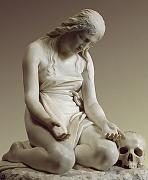  But as
noted by Steinberg, de Caso/Sanders and
Jamison, Mary Magdalene's adoration of Christ was not without erotic
connotation. De Caso/Sanders point to the Mystic Union between devout women
and the body of Christ, and list some art-historical examples that may have inspired
Rodin to include this saint - a repenting prostitute like 'The Old
Courtesan'
- in his work: the well-known statue by Canova (1796)
showing a sensual Mary Magdalene with shoved-up skirts, the converted
strumpet Esther in Balzac's 'Splendeurs et Misères des Courtisanes'
(1838) and Félicien's Rops's frontispice for 'L' Amante du Christ' by
Rodolphe Darzens.
Especially the drawing by Rops, which Rodin may have known, conflates
religious worship with carnual stimulation and unconcealed fantasies of
sexual submissiveness. But as
noted by Steinberg, de Caso/Sanders and
Jamison, Mary Magdalene's adoration of Christ was not without erotic
connotation. De Caso/Sanders point to the Mystic Union between devout women
and the body of Christ, and list some art-historical examples that may have inspired
Rodin to include this saint - a repenting prostitute like 'The Old
Courtesan'
- in his work: the well-known statue by Canova (1796)
showing a sensual Mary Magdalene with shoved-up skirts, the converted
strumpet Esther in Balzac's 'Splendeurs et Misères des Courtisanes'
(1838) and Félicien's Rops's frontispice for 'L' Amante du Christ' by
Rodolphe Darzens.
Especially the drawing by Rops, which Rodin may have known, conflates
religious worship with carnual stimulation and unconcealed fantasies of
sexual submissiveness.
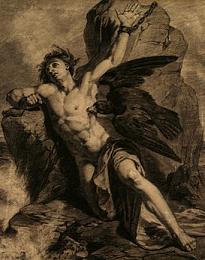 The alternative titles
support Elsen's analysis and add new layers of meaning: 'Prometheus and the Oceanid'
refers to the rebellious Titan who had stolen the fire from the Olympus
and brought it back to mortal mankind; as a punishment, Prometheus was chained
to a rock, visited daily by an enormous eagle eating his liver. Gifted with
forethought and unwilling to accept the compromises Zeus offered him, he was perceived as the prototype of
the uncorruptable hero, suffering for saving humanity from the dark and
the cold. The
drawing by Christian Schüssele (1824-79) shows an idealized, suffering
Prometheus during his daily ordeal. The alternative titles
support Elsen's analysis and add new layers of meaning: 'Prometheus and the Oceanid'
refers to the rebellious Titan who had stolen the fire from the Olympus
and brought it back to mortal mankind; as a punishment, Prometheus was chained
to a rock, visited daily by an enormous eagle eating his liver. Gifted with
forethought and unwilling to accept the compromises Zeus offered him, he was perceived as the prototype of
the uncorruptable hero, suffering for saving humanity from the dark and
the cold. The
drawing by Christian Schüssele (1824-79) shows an idealized, suffering
Prometheus during his daily ordeal.
The third denomination for Rodin's work, 'The Genius and Pity',
puts
the couple in the context
of the sculptor's allegorical studies on the relationship
between the gifted artist and his muse - a subject Rodin extensively
explored while designing his 'Monument to Victor
Hugo'. Another work
dealing with this subject, 'The Poet and
Love' (1896), shows the male protagonist in a pose reminding of 'The
Torturted Prometheus', painted by Gustave Moreau in 1868.
To the Romantic mind,
is was not uncommon to identify the roles of Christ,
Prometheus and Poet/Genius/Artist with each other; another example in
Rodin's own work is 'The Thinker', merging Dante's role as a brooding artist-philosopher with that of Christ in the Judgement
seat  : the
triumphant reversal of Golgotha's agony. But also
other artists from the turn of the century associated the innovative virtues of genius with pain and hardship. : the
triumphant reversal of Golgotha's agony. But also
other artists from the turn of the century associated the innovative virtues of genius with pain and hardship.
Mary Magdalene, on the other hand, assumes the role of
the Oceanid, comforting Prometheus in Aeschylus drama
, respectively that of the Muse - the proper function of 'The
Meditation' in Rodin's rejected 'Monument to
Victor Hugo', portraying another uncorruptable, exiled hero.
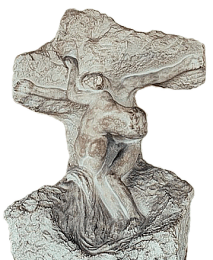 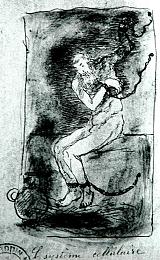 The fourth strand of meaning - underneath the religious,
mythological and allegorical layers - is auto-biographical.
According to Elsen, Rodin produced his 'Christ and Mary Magdalene' group without
being commissioned, as a portrait of his breaking-up relationship with
Camille, who possibly had been his model for the 'Meditation' figure.
His hands fastened to the wall behind him, Rodin's
Christ-Prometheus-Genius is not able to embrace the woman
adoring him. Except for the arms, his pose is nearly identical to the
biting caricature portrait Camille sketched in 1892, 'The cellular
System', showing Rodin chained to the wall of a prison cell, guarded by
Rose with a broom.
I could not determine yet if Rodin by 1895 did have knowledge of this
sketch, but the similarity of both form and motif is almost too
strong to be purely coincidental. The fourth strand of meaning - underneath the religious,
mythological and allegorical layers - is auto-biographical.
According to Elsen, Rodin produced his 'Christ and Mary Magdalene' group without
being commissioned, as a portrait of his breaking-up relationship with
Camille, who possibly had been his model for the 'Meditation' figure.
His hands fastened to the wall behind him, Rodin's
Christ-Prometheus-Genius is not able to embrace the woman
adoring him. Except for the arms, his pose is nearly identical to the
biting caricature portrait Camille sketched in 1892, 'The cellular
System', showing Rodin chained to the wall of a prison cell, guarded by
Rose with a broom.
I could not determine yet if Rodin by 1895 did have knowledge of this
sketch, but the similarity of both form and motif is almost too
strong to be purely coincidental.
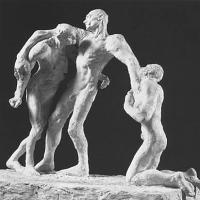 Still
in 1894, Camille would start developing 'Maturity', based on sketches she had confided to her brother Paul by the end of 1893. Camille's trio designates who is absent
in Rodin's composition: the jealous old woman Rose Beuret, dragging the
undecisive man
in the center away from his begging young lover. Considered as the
counterpart to 'Christ and Mary Magdalene, 'Le dieu envolé' gains a very
concrete meaning: Christ has once and for all ascended to heaven. Still
in 1894, Camille would start developing 'Maturity', based on sketches she had confided to her brother Paul by the end of 1893. Camille's trio designates who is absent
in Rodin's composition: the jealous old woman Rose Beuret, dragging the
undecisive man
in the center away from his begging young lover. Considered as the
counterpart to 'Christ and Mary Magdalene, 'Le dieu envolé' gains a very
concrete meaning: Christ has once and for all ascended to heaven.
In 1907, a few lines from a poem by Laurent Tailhade
were attached to a reproduction of Rodin's group, adding to its
interpretation as a
valediction to the sculptor's pupil, lover and spiritual companion (see
also 'Farewell'):
For one evening he bent towards
you his head
For when his great soul was ready to take flight
You received at his feet his immortal farewell.
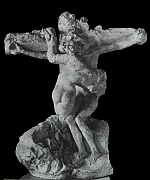 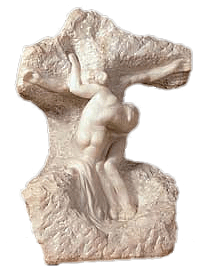 'Christ and Mary Magdalene' was first
saved as a
plaster, now kept in the reserves of Meudon.
In this early version, the bodies of Chtist and Mary Magdalene do not
actually touch each other. Only in the marble versions subsequently
carved, the marcottage of the 'Meditation' and the
Christ-Prometheus-Genius is adapted into a unified design, allowing for a
more natural joining - just like in the case of 'The Fallen
Angel', created ca. one year
later in 1895. In this latter work, also based on an assemblage of
disparate figures, the
'Crouching Woman' has taken over the function of supporting, comforting and
deploring her defeated partner, and here as well, her solacing embrace
can be read as intimate caressing. 'Christ and Mary Magdalene' was first
saved as a
plaster, now kept in the reserves of Meudon.
In this early version, the bodies of Chtist and Mary Magdalene do not
actually touch each other. Only in the marble versions subsequently
carved, the marcottage of the 'Meditation' and the
Christ-Prometheus-Genius is adapted into a unified design, allowing for a
more natural joining - just like in the case of 'The Fallen
Angel', created ca. one year
later in 1895. In this latter work, also based on an assemblage of
disparate figures, the
'Crouching Woman' has taken over the function of supporting, comforting and
deploring her defeated partner, and here as well, her solacing embrace
can be read as intimate caressing.
The
marble carvings of 'Christ and Mary Magdalene are exhibited in the Musée Rodin and in the
Collection Carmen Thyssen-Bornemisza. From the Thyssen-Bornemisza marble
copy, new plasters were drawn, now exhibited in the San Francisco and
Maryhill Museums.
|
 following the
death of his sister Maria.
He rather fostered a pantheist vision, in which any element of Life and
Nature could be perceived as a representation of truth and beauty.
His occupation with a clearly religious
subject like 'Christ and Mary Magdalene' in 1894 is an exception and needs
some attention.
following the
death of his sister Maria.
He rather fostered a pantheist vision, in which any element of Life and
Nature could be perceived as a representation of truth and beauty.
His occupation with a clearly religious
subject like 'Christ and Mary Magdalene' in 1894 is an exception and needs
some attention.
 pedestal.
Finally, his passionate affair with Camille Claudel had reached the stage
of permanent crisis, Camille and Rose combatting each
other openly. In
this adversary situation, the sculptor could easily identify with the character of
Christ - a man with a higher mission, betrayed, captured and tormented. For
solace, a kneeling 'Meditation' was added, holding the
the tortured Saviour in her arms. Maybe it was no coincidence Rodin at his
point in time evoked the figure of Mary Magdalene, bearing the name of his
beloved sister.
pedestal.
Finally, his passionate affair with Camille Claudel had reached the stage
of permanent crisis, Camille and Rose combatting each
other openly. In
this adversary situation, the sculptor could easily identify with the character of
Christ - a man with a higher mission, betrayed, captured and tormented. For
solace, a kneeling 'Meditation' was added, holding the
the tortured Saviour in her arms. Maybe it was no coincidence Rodin at his
point in time evoked the figure of Mary Magdalene, bearing the name of his
beloved sister.


 The alternative titles
support Elsen's analysis and add new layers of meaning: 'Prometheus and the Oceanid'
refers to the rebellious Titan who had stolen the fire from the Olympus
and brought it back to mortal mankind; as a punishment, Prometheus was chained
to a rock, visited daily by an enormous eagle eating his liver. Gifted with
forethought and unwilling to accept the compromises Zeus offered him, he was perceived as the prototype of
the uncorruptable hero, suffering for saving humanity from the dark and
the cold. The
drawing by Christian Schüssele (1824-79) shows an idealized, suffering
Prometheus during his daily ordeal.
The alternative titles
support Elsen's analysis and add new layers of meaning: 'Prometheus and the Oceanid'
refers to the rebellious Titan who had stolen the fire from the Olympus
and brought it back to mortal mankind; as a punishment, Prometheus was chained
to a rock, visited daily by an enormous eagle eating his liver. Gifted with
forethought and unwilling to accept the compromises Zeus offered him, he was perceived as the prototype of
the uncorruptable hero, suffering for saving humanity from the dark and
the cold. The
drawing by Christian Schüssele (1824-79) shows an idealized, suffering
Prometheus during his daily ordeal.

 : the
triumphant reversal of Golgotha's agony. But also
other artists from the turn of the century associated the innovative virtues of genius with pain and hardship.
: the
triumphant reversal of Golgotha's agony. But also
other artists from the turn of the century associated the innovative virtues of genius with pain and hardship.



 'Christ and Mary Magdalene' was first
saved as a
plaster, now kept in the reserves of Meudon.
In this early version, the bodies of Chtist and Mary Magdalene do not
actually touch each other. Only in the marble versions subsequently
carved, the marcottage of the 'Meditation' and the
Christ-Prometheus-Genius is adapted into a unified design, allowing for a
more natural joining - just like in the case of
'Christ and Mary Magdalene' was first
saved as a
plaster, now kept in the reserves of Meudon.
In this early version, the bodies of Chtist and Mary Magdalene do not
actually touch each other. Only in the marble versions subsequently
carved, the marcottage of the 'Meditation' and the
Christ-Prometheus-Genius is adapted into a unified design, allowing for a
more natural joining - just like in the case of